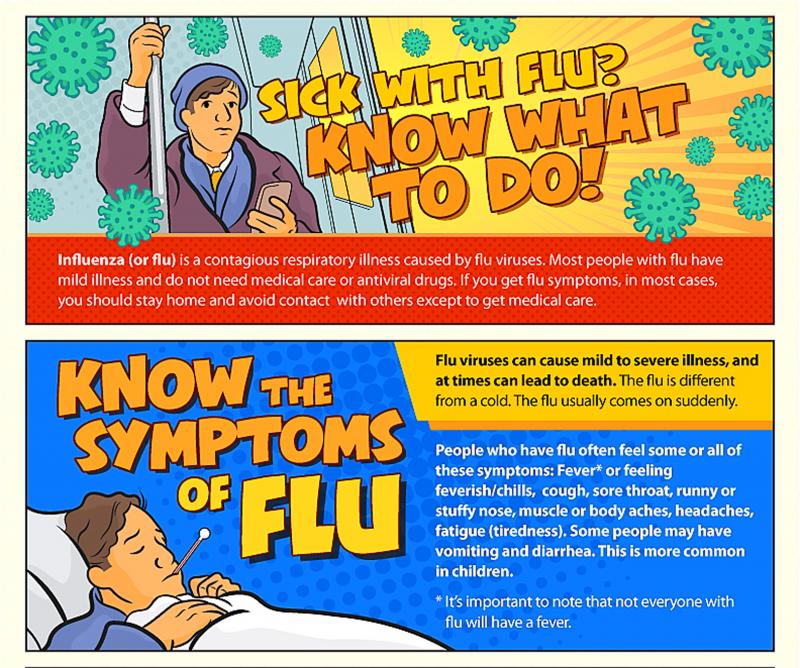Influenza, commonly known as the flu, is prevalent in fall and winter. People may wonder how one can tell the difference between influenza and a cold. Influenza is an acute respiratory tract disease caused by influenzaviruses, whose main routes of infection are via airborne droplets and contact. The difference between the flu and what we generally call a cold is that ordinary colds can be caused by many kinds of virus, some of the common ones being rhinovirus, respiratory syncytial virus (RSV) and adenoviruses.
Influenzaviruses are classified into types A to D, of which only types A and B can cause seasonal influenza outbreaks. Type A influenza includes the H1N1 and H3N2 subtypes, while type B includes two lineages called B/Victoria and B/Yamagata.
The Taiwan Centers for Disease Control (CDC) explains that colds mainly cause respiratory tract symptoms such as sore throat, sneezing and runny nose, sometimes accompanied by a fever, whereas influenza symptoms are systemic, meaning that they affect the whole body. As well as experiencing more serious fever, fatigue and cough symptoms than one would with a cold, some flu patients also suffer from gastrointestinal symptoms such as nausea, vomiting and diarrhea. Other commonly seen symptoms include muscular weakness, headaches etc. In severe cases, influenza may also cause serious complications such as encephalitis and myocarditis.

Photo courtesy of the US CDC照片:美國疾病管制中心提供
The CDC says that babies and children under school age are a high-risk group for influenza complications, and flu vaccines do not produce sufficient protection until two weeks after vaccination, so if you have children aged over six months old but below school age, they should be given a flu vaccine as soon as possible.
Fall and winter are the seasons when it is easiest to catch the flu. In Taiwan, influenza breakouts tend to steadily increase starting in November, reaching a peak in the next year around Lunar New Year and gradually reducing from March onward. The CDC reminds the public that if you experience three kinds of symptom, namely fever, aches (including headaches and distinct muscular aches) and fatigue, you must be aware that it could be the flu. Furthermore, influenza is highly contagious, and if people with the flu cough or sneeze in closed spaces while not wearing a mask, they can easily spread the virus to others.
(Translated by Julian Clegg, Taipei Times)
秋冬流感盛行,大家可能會疑惑,該如何區分流感和感冒呢?流感是由流感病毒所引起的一種急性呼吸道疾病,主要經由飛沫與接觸途徑傳染。和我們一般說的感冒不同,一般感冒可能由多種病毒引起,常見的包括鼻病毒、呼吸道融合病毒,及腺病毒等。
流感病毒有A-D型,只有A型及B型流感病毒可以引起季節性流感流行,包括A型的H1N1及H3N2兩種亞型,與B型流感病毒的B/Victoria及B/Yamagata兩種。
台灣疾病管制署說明,感冒以呼吸道症狀為主,如喉嚨痛、打噴嚏、流鼻水等症狀,偶爾伴隨發燒。而流感的症狀是全身性的,不但發燒、疲倦和咳嗽症狀比感冒更嚴重,有部分感染者會伴隨噁心、嘔吐以及腹瀉等腸胃道症狀,也常出現肌肉無力和頭痛等症狀,嚴重者還會引起腦炎和心肌炎等併發症。
疾管署指出,學齡前的嬰幼兒是流感併發症的高危險群,而流感疫苗在施打兩週後才會產生足夠保護力,因此若家中有六個月以上至學齡前的兒童,應儘速施打流感疫苗。
秋冬是流感好發的季節。在台灣,一般約於十一月開始,流感疫情就會緩慢上升,至隔年農曆春節前後達到高峰,三月後逐漸下降。疾管署提醒,如果出現「一燒(發燒)」、「二痛(頭痛、明顯肌肉酸痛)」、「三疲倦」就須警覺是流感。且流感傳染性高,在密閉空間內,若流感患者未戴口罩就咳嗽或打噴嚏,就容易將病毒傳染給別人。
(自由時報)

Many people have heard the exaggerated stories of crazed schools of “piranhas” lurking beneath the waters of the Amazon River. Interestingly, it was US President Theodore Roosevelt who helped popularize these tales. He famously called piranhas “the most ferocious fish in the world,” which cemented their fearsome reputation. However, piranhas are not as violent as Roosevelt’s account, Hollywood movies, and adventure novels portray them. Far from being ruthless killers, piranhas typically feed on worms, insects, small fish, and plants, helping maintain healthy river ecosystems. However, during the dry season, when water levels are low and food is scarce, they

★ Bilingual Story is a fictionalized account. 雙語故事部分內容純屬虛構。 Wu Gang bent low, his axe heavy in his hands. Sweat rolled down his back. He struck the osmanthus tree. The wound closed again. He paused to breathe. He admired the branches, glowing against black silence of space. He smelled the blossoms, sweet but fleeting. Long ago, he drank deep of wine. He chased fast pleasures. He sought the potion of immortality. Not to escape death, but to merge with the Dao. Yet he hurried. He demanded the quick path. The Jade Emperor saw his heart. Desire without patience. So

Returning to the White House with unprecedented economic weaponry, US President Donald Trump has launched a comprehensive tariff offensive that has sent shockwaves through international markets. On April 2, Trump announced his “reciprocal tariff” strategy, aimed at punishing trading partners who sell more to the US than they buy in return. Central to his policy is the disputed view that such trade deficits harm the US economy. While Trump later suspended most of the tariffs to allow time for negotiations, some still went into effect, and the others remain a looming economic threat. Tariffs, essentially taxes imposed on imported goods, raise

Continued from yesterday(延續自昨日) https://www.taipeitimes.com/News/lang “Piranhas” may make great material for horror and adventure stories, but in reality, they rarely attack humans. While people fear piranhas, it is often humans who pose a greater threat to them through overfishing, pollution, and habitat disruption. In many parts of the Amazon, piranhas have long been a common food source and are often grilled or cooked in soup. Their razor-sharp, triangular teeth are also used by locals to make tools for cutting and carving. These teeth are tightly packed, interlock like a saw blade, and are strong enough to remain useful even after the fish